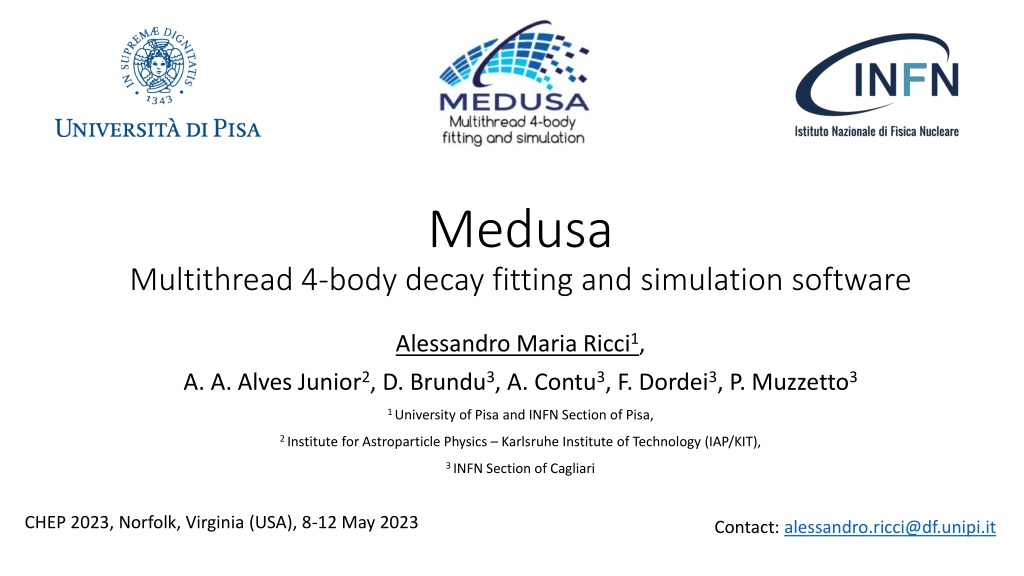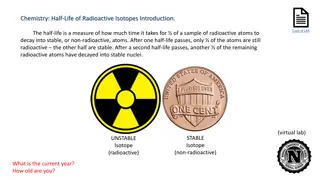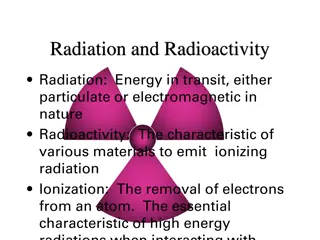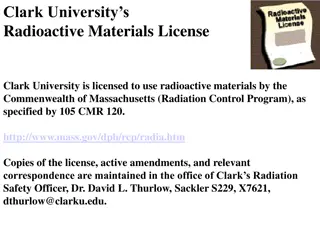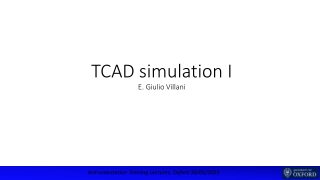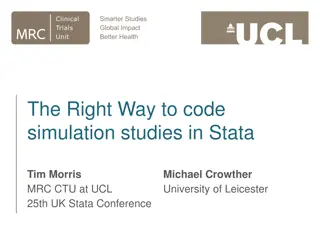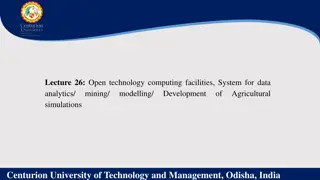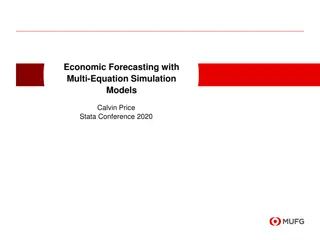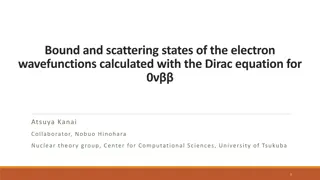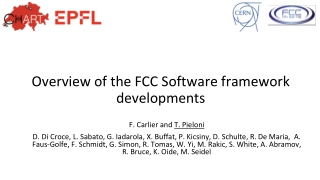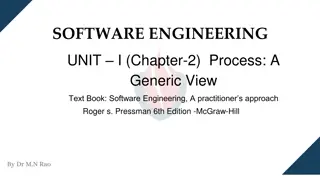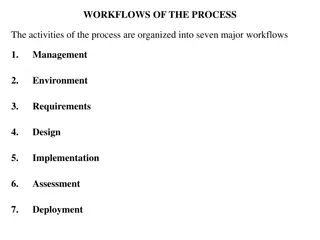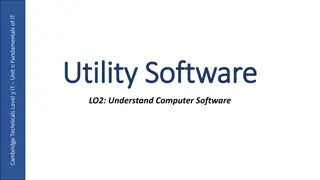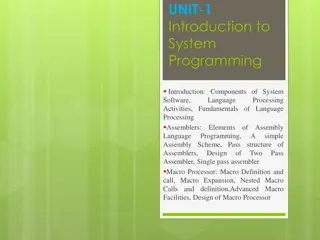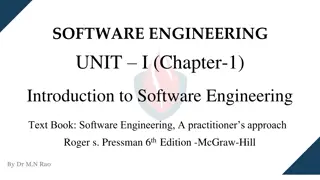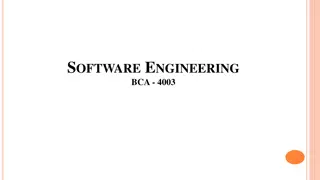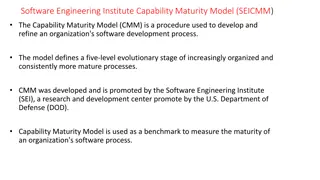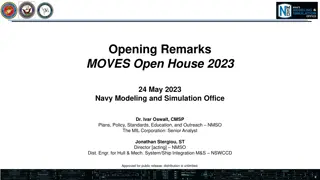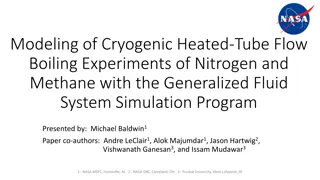Medusa - Multithread 4-Body Decay Fitting and Simulation Software
Medusa is a C++ application for physics data analyses of 4-body decays in massively parallel platforms. It aims to optimize complex data modeling processes by leveraging multithreading capabilities for efficient performance, particularly in High Energy Physics experiments. Medusa has been successfully utilized in CP-violating phase measurements at LHCb, showcasing its effectiveness in handling intricate data analyses within the field.
Download Presentation

Please find below an Image/Link to download the presentation.
The content on the website is provided AS IS for your information and personal use only. It may not be sold, licensed, or shared on other websites without obtaining consent from the author. Download presentation by click this link. If you encounter any issues during the download, it is possible that the publisher has removed the file from their server.
E N D
Presentation Transcript
Medusa Multithread 4-body decay fitting and simulation software Alessandro Maria Ricci1, A. A. Alves Junior2, D. Brundu3, A. Contu3, F. Dordei3, P. Muzzetto3 1 University of Pisa and INFN Section of Pisa, 2 Institute for Astroparticle Physics Karlsruhe Institute of Technology (IAP/KIT), 3 INFN Section of Cagliari CHEP 2023, Norfolk, Virginia (USA), 8-12 May 2023 Contact: alessandro.ricci@df.unipi.it
Content The scientific case Medusa Use case: ??0 ??0 ?/? ? ?+? ?+? decay at LHCb Signal-only model Amplitudes and angular distributions Coefficients in the time functions Flavour tagging Experimental artifacts and simultaneous fit Probability Density Function (PDF) Validation Performance Conclusions and distribution 2
The scientific case Among the biggest computational challenges for High Energy Physics (HEP) experiments, there are the increasingly larger datasets that are being collected, which often require correspondingly complex data analyses. In particular, the PDFs used for data modelling become more and more complicated, with hundred of free parameters. The optimization of such models involves a significant computational effort and a considerable amount of time, of the order of days, before reaching a result. The current strategy to increase overall performance is to parallelize the software in order to benefit from the large performance gains that can be achieved with multithreading in CPU and/or GPU. Despite ongoing modernization efforts, a large fraction of the software used in HEP is inherited. It consists of libraries of single threaded, mono-platform routines. 3
Medusa Medusa is a C++ 14 compliant application to perform physics data analyses of generic 4-body decays in massively parallel platforms on Linux systems. link Medusa is highly based on Hydra v3.0 (link), a C++ 14 compliant and header only library that hides most of complexities of writing parallel code for different architectures. Hydra provides a collection of containers and algorithms commonly used in HEP data analysis, which can transparently exploit enabled devices for OpenMP, CUDA, and TBB, allowing the user to re-use the same code across a large range of available multi-core CPU and GPU. Medusa wants to be a set of ready-made models to perform data analysis, as the CP-violating phase model in ??0 ??0decay, and ready-made multithread functions, as the Fadeeva functions, to accelerate the develop of new models. 4
Use case: ??0 ??0decay at LHCb Medusa has been tested through the measurement of the CP-violating phase ??in ??0 ??0 ?/? ? ?+? ?+? decay, one of the golden channels for this type of research at LHCb. Between 2015 and 2016, LHCb Collaboration collected a sample of about 209000 events. For extracting the phase ??is necessary to perform a maximum-likelihood fit with 32 free parameters, by using a model which includes both the signal and the background. This model must include the modeling of the distribution of the ??0-decay times, of the decay angles, of the so-called flavour tagging to distinguish between ??0and ??0mesons and other experimental artifacts. 5
Signal-only model The full time- and angle-dependent decay rate is (Eur. Phys. J. C (2019) 79, 106 , Eur. Phys. J. C (2020) 80, 601 and Stemmle, Ph.D. Thesis, Heidelberg, Germany, 2019): 10 d4 ?? ??? ??? ?? ?? ?,?? ????,??,? Signal-only model ?=1 4?? ???cosh ? 3 + ??sinh ? ??? ??0 ?,1? = + ??cos ? ? + ??sin ? ? 2 2 4?? ???cosh ? 3 + ??sinh ? ??? ??0 ?, 1? = ??cos ? ? ??sin ? ? 2 2 Free parameters: = ?+ ? , = L H, ? = ?? ??. 2 6
Coefficients in the time functions Coefficients in the time functions ?,1? and ?, 1? with the polarization dependent CP violation. Free parameters: 0, 0, 0, ? 0,?0, ? ?0, ? ?0 , ?? ?0, ?0, ? ?0, ? ?0 , ?? ? . 7
Amplitudes and angular distributions Figure on the left: angular distribution in the helicity basis describing the decay geometry. Figure on the right: polarization amplitudes of the system ?/??. The short arrows indicate the spin orientation of the two vector mesons. Table: definition of the polarization amplitudes ??and the angular functions ????,??,? . 2. 2,? 2,?? Free parameters: ?0 8
Flavour tagging In LHCb, the tagging algorithms (taggers) can be divided into two classes. The opposite-side (OS) taggers rely on the fact that b quarks are predominantly produced in ? ? pairs and try to infer the initial flavour from the decay chain of the respective other b quark. The same-side (SS) taggers exploit the charge of particles that are created in association with the fragmentation of the signal b quark. Each tagger returns 2 values: ? = 1 ??0,0 no tagged , 1 ??0 ? = mistag probability ?0, ?0,?1, ?1 are free parameters. ? ? = ?0+ ?0 + ?1+ ?1 ? ? = ?0 ?0 + ?1 ?1 ? ? ??? ??0 ? ? ??? ??0 2 2 2 2 9
Experimental artifacts and simultaneous fit The signal-only model has 18 free parameters. Flavour tagging adds 4 free parameters. We need to consider other experimental artifacts: decay-time resolution, decay-time and angular acceptances, S-wave. Decay-time resolution, decay-time and angular acceptances increase the model complexity without raising the number of free parameters. The S-wave is composed of ?+? -couples, which originate from the direct decay ??0 ??0 ?/? ?+? . This contribution has a different angular distribution and then must be separated from the signal-only model. The S-wave is split in the 6 ???-bins: 990 1008 , 1008 1016 , 1016 1020 , 1024 , 1024 1032 , 1032 1050 ?2. The 2 S-wave associated parameters, ?S This brings to a simultaneous fit on 6 ???-bins with 20 free parameters in common between the bins and 2 specific for each bin. Hence, totally we have 32 free parameters. Finally, the background is considered by associating a weight to each event, which indicates the probability that the event is a signal or background. 1020 ??? 2and ?? ? , are left free to vary in each bin. 10
Probability Density Function (PDF) ? ?, ???,???, ??, ??, ? = ????,? ???-bins for S-wave 10 1 ??? ?,?? ?? ??, ??, ?,? Cubic Spline for time acceptance Effective Gaussian for time resolution ????,???,?,? ?=1 1 + ???1 2 ?? ?? 1 + ???1 2 ?? ?? ?,1? + 1 ???1 2 ?? ?? 1 ???1 2 ?? ?? ?, 1? ? ?| ??? ? Tagging coefficients 11
Normalization Factor ???-bins for S-wave Cubic Spline for time acceptance ??, ??, ?,?= ????,???,?,? Coefficients for angular acceptance 10 15 ?? ? ?,?? ?,? Tagging coefficients ?? ? Effective Gaussian for time resolution ?=0.3 ?? ?=1 1 + ???1 2 ?? ?? 1 + ???1 2 ?? ?? ?,1? + 1 ???1 2 ?? ?? 1 ???1 2 ?? ?? ?, 1? ? ?| ??? ? ?? The normalization factor can be analytically computed, but the computation is expensive. 12
Validation Difference between LHCb and Medusa Statistical uncertainties in LHCb ?????? ???= 0.0009 ???????= 0.043 ???? ?0 ?= 0.013 ????= 0.045 ?0 ???? ?= 0.00055 ??0 ? ????= 0.0024 ???? ?= 0.0007 ? ????= 0.0077 ????? ??= 0.029 ? ? = 0.060 2,???? ? 2,?= 0.0035 2,????= 0.025 ? ?? 2,???? ?0 2,?= 0.0011 2,????= 0.018 ?0 ??0 ???? ?0 ???? ? ? ?0 ? ???? ?0 ????= 0.15 ? = 0.031 ? ? ???? ?0 = 0.029 ???? ?0 ? ?0 ???? ? ? ????= 0.083 ? ? ? The comparison has been done with the results reported in LHCb-ANA-2017-028. 13
Performance System Time/call (ms) AMD EPYC 7452 @ 1.50 GHz (1 Threads) 30424 AMD EPYC 7452 @ 1.50 GHz (128 Threads) 419 NVIDIA A100 92 The table summarizes the time spent to perform the objective function (FCN) evaluation with 500k events. 14
Conclusions HEP experiments collect ever-larger datasets and their analyses get more and more complex. Moreover, the PDFs used for data modelling become more and more complicated, with hundred of free parameters. Not rarely, a computation spends hours to reach a result, which very often needs to be re-tuned. Medusa is a multithread 4-body decay fitting and simulation software created to speed up the physics data analysis. As a use case, we used the measurement of CP-violating ??-phase in ??0 ??0 ?/? ? ?+? ?+? decay, one of the golden channel for this type of research at LHCb. The evaluation time of the objective function (FCN) with 500000 events is about 92 ms on CUDA, which is about 330 times faster than a non-parallelized software. The compilation times also have been optimized. The GCC compiler spends about 1 minute to create the executable for TBB and OpenMP and NVCC about 4 minutes for CUDA. 15
Distribution Medusa will be released on GitHub as open-source software under GPL v.3.0 license soon. If you are interested in the software, you can contact: 1. andrea.contu@cern.ch 2. francesca.dordei@cern.ch 3. alessandro.ricci@df.unipi.it, alessandro.ricci@pi.infn.it 4. davide.brundu@cern.ch 16
Backup 18
CP-violating phase ?? Typically, the phase of the transition amplitude ? can be split into a strong phase ?, which does not change sign, and a weak phase ?, which changes sign under CP transformation: ??? = ?? ? ?? ?+?= ? ?? ?+?. The heavy and light eigenstates are: ??0, ??0 0 0 ??0+ ?| ??0 ?| = ?| = ?| ??,? ??,? ??0, we have ??0and ??/??= Given the transition amplitudes ??/??= ?/?? H | ?/?? H | ??/?? ??/?? ??/??=? = ??/?????? ? The CP is violated if ?? 0. 19
Normalization factor 10 10 15 ?? 15 ?? ? ?,?? ?,? ? ?,? ?? ?? ? ? ???? ? ?? ?,?? ???? ? ?? ?=0.3 ?? ?=0.3 ?? ?=1 ?=1 10 15 ?? ? ?,? ?? ? ???3+ ???2+ ??? + ?? ???? ? ?? ?=0.3 ?? ?=1 10 7 7 ??+1 ??+1 ? ?,? ?? ? ?3 ???? ? ?? ?2 ???? ? ?? ?? ?? ?? ?? ?=1 ?=1 ?=1 7 7 ??+1 ??+1 + ?? ? ???? ? ?? + ?? ???? ? ?? ?? ?? ?=1 ?=1 20
Normalization Factor ??+1 ??+1 ?? ???? ? ?? ?? ???? ?? ?,?? ? ?| ??? ? ?? ?? ?? ?? ? ? 3???????????! 8? 2 2???? 2? 1 ?! ? ? ! ?? ???1?? ??1,?2;?1 + ???2?? ??1,?2;?2 ?=0 + ?? ???1?? ??1,?2;?1 ???2?? ??1,?2;?2 + ??? ???3?? ??1,?2;?3 + ???4?? ??1,?2;?4 +??? ? ???3?? ??1,?2;?3 ???4?? ??1,?2;?4 21
